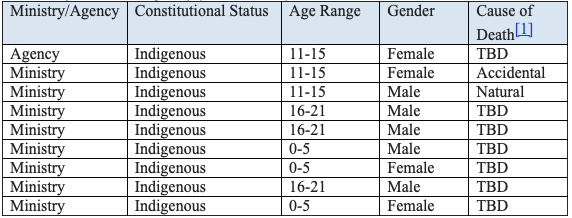Saskatchewan set a grim record in 2020, with the highest number of child welfare deaths in recent history.

New data obtained by Global News shows the province’s social services ministry recorded 36 deaths last year, including children and youth aged 0 to 21.
Ministry data for the past 13 years shows 2020 saw the most deaths involving children connected to the child welfare system.
Nine of the children who died last year were in government care, while the remaining 27 had received social services within the past 12 months, according to the ministry.
Every child who died was Indigenous, except for one boy who received services.
“Every time there’s a loss of a child, of course it’s heartbreaking,” said Federation of Sovereign Indigenous Nations vice chief David Pratt.
While the cause of most of the deaths is to be determined, the ministry said at least three were “accidental” and six were “natural.” Causes of death are determined by Saskatchewan’s coroner’s services, and can also include suicide, homicide or undetermined causes.
“The Ministry of Social Services works with very vulnerable children and youth, and this includes those who are medically fragile, and who may experience complex health challenges,” said Joel Kilbride, the ministry’s executive director of program and service design.
“We’re continuing to work with parents and caregivers on key issues such as safe sleeping practices, and suicide intervention and prevention.”
In the coming weeks, Pratt said he hopes to meet with Saskatchewan social services minister Lori Carr, who was appointed to the role in November.
“This will be one of the things that will be the topic of our conversation, in terms of some of the accountability and what happened and what went wrong,” Pratt said.

Get daily National news
The ministry reviews the circumstances surrounding each death to determine whether it needs to make any changes, and how future deaths can be prevented. The internal reviews are shared with the provincial children’s advocate.
The Office of the Advocate for Children & Youth declined an interview request, but said more information will be available this spring.
“We are still analyzing the numbers and the Advocate will have more to say on this in her Annual Report that will be released sometime in March or April,” the office’s human resources manager, Wanda George, said in an email.
In August, Global News reported the province was on track to top 2019’s numbers. At the time, children’s advocate Lisa Broda said it was too soon to tell why deaths are tracking upward.

Pratt said it’s largely a symptom of social inequities created by colonialism.
“It’s all directly connected to the social determinants of health,” he said.
Some of the social determinants of health are income, education, housing and race. They likely played a role in the loss of children who died of natural causes, Pratt said.
“The vast majority of our population lives in urban centres — basically urbanized ghettos in Regina and Saskatoon,” he said.
“We’ve got to seriously address some of those inequities.”
Investing in education, poverty reduction and addictions supports could help drive the numbers down, he said.


If you’re concerned about the well-being of a child, please contact the Office of the Saskatchewan Advocate for Children & Youth.



Comments